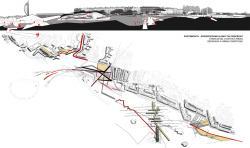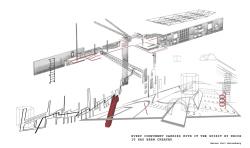The project is about defining a design methodology efficient enough to influence the variety of forces shaping the built environment. The ultimate aim is to develop a toolkit for adaptation options of urban areas imposed to different current urban conditions.We are not interested in proposing a general and idealized model of urban conditions, but i am questioning the design process itself. The focus is to develop a design approach that will reveal the authentic power of design itself to influence forces that shape the built environment.
This research deals with 3 sites with urban discontinuities. The basis is evidence based critical-experimental approach. The idea is to stimulate those areas and convert the voids into spines of growth. The output of the research is determining urban design components which act as guidelines for the process of design. The ultimate aim is to reach to design solutions through the process of “tactile urban design”.
2009
First we analyze forces of the context, whichwe supplement with urban design components that are not fixed elements but models for a process, though they contain the ability to project a series of spaces and surfaces flexible to evolve while at the same time being specific enough to give a direction for future growth.
WE SUPPORT THE APPROACH TO URBAN DESIGN THAT FOCUSES ON HOW AND WHY THE LINES ARE DRAWN, HOW THEY GROW OUT OF THE CONTEXT, HOW THEY CORRELATE TO REACH THE LEVEL THAT WILL BE EFFICIENT ENOUGH TO ACT AS A COMPLEX SYSTEM.
WE OPPOSE TO SUPERFICIALLY IMPOSING PROGRAMS AS I BELIEVE THAT THE DRAWING ITSELF SHUOLD REVIEAL THEM.
WHAT IS DIFFERENT IN THIS METHOD IS THE WAY WE APPROACH URBAN DESIGN AS A PROCESS ITSELF.
ONLY WHEN ALL LINES THAT ARE DERIVED FROM THE CONTEXT REACH COMPLEXITY IT IS TIME TO TRANSLATE THEM INTO SPACES.
Stavroula Papafotiou
Daria Shipukhina
Favorited 1 times










